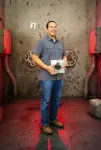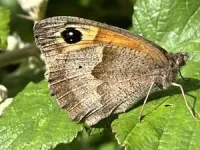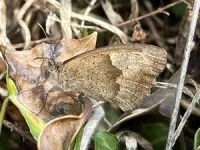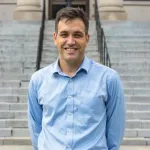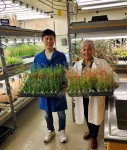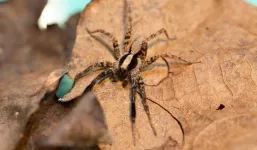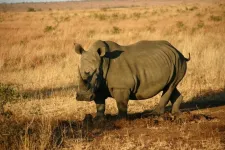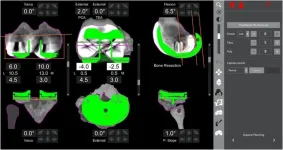(Press-News.org) ALBUQUERQUE, N.M. — Tony Garcia often reflects on his grandfather’s words: “Work hard and be good to people, and you’ll end up happy.”
This simple principle has been Garcia’s beacon throughout his academic and professional journeys, and now has led to his recognition with a prestigious 2023 Society of Hispanic Professional Engineers STAR of Today award for technical achievement.
The STAR awards recognize individuals in STEM who are not only excelling in their fields but also making a significant impact through their work, research and community outreach.
“This is a really big deal for me,” Garcia said. “I strive to make a difference in my career and life while not standing out, so receiving this award feels both exciting and a little awkward. But I share this recognition with my colleagues because we’ve accomplished something together, which makes it even more meaningful.”
The grandson of immigrants, Garcia watched as the generations before him struggled to make ends meet. “My grandfather brought his young wife and four children from Chile to America in pursuit of the American dream,” Garcia said. “My mom was 8 years old before her first car ride.
“Eventually my dad went to college while working construction and earned a degree in computer science,” he said. But their struggles lingered, and Garcia’s parents urged him to seek job stability rather than advanced degrees, a sentiment shaped by their own experiences. “That was probably a byproduct of their young lives,” he said. “They were always very loving and supportive.”
However, Garcia’s determination led him to a doctorate in mechanical engineering at the University of New Mexico. His decision was strongly supported by his grandfather, who had been an engineer in Chile before fleeing political unrest.
“He really understood what I was going through,” Garcia said. “The sacrifices involved — the financial sacrifice, missed opportunities and a delayed career. He always encouraged me to pursue my education and acquire as much knowledge as possible. ‘Just continue getting your degree,’ he would say. ‘Keep improving your education. Learn as much as you can, and things will work out.’”
During his doctoral studies, Garcia seized an opportunity to intern at Sandia Labs, where he researched nuclear fuels. The experience not only helped shape his dissertation but also introduced him to Sandia’s team-science culture, dedicated to addressing vital national security missions. Garcia was inspired by the work of the team and found his calling in contributing to global security.
“It was a great fit,” he said. “This was a place I wanted to be. I love being a part of an effort to keep the world safe.”
Since joining Sandia in 2007, Garcia has played a pivotal role in developing concepts, advancing technologies, enhancing diagnostics, supporting production and resolving complex issues to address national security challenges. His responsibilities include creating test plans, procedures and reports; crafting project proposals and specifications; optimizing manufacturing processes and conducting statistical analyses of experimental data.
“It’s been a really rewarding journey, and I believe our team has accomplished a great deal for the Labs and the nation,” he said.
Community connections
While Garcia’s professional accomplishments are impressive, his personal commitment to community engagement is equally inspiring.
“As we gain levels of success, we must remember to look back and reach out to those who are coming up behind us,” he said. “It only takes a few key people at key moments in life to inspire a generation. We can have an enormous impact on the lives of others.”
As a UNM student, Garcia actively participated in a NASA training project, providing academic and financial support to underrepresented science students.
Currently, he volunteers for various STEM outreach programs, including through UNM’s Young Children’s Health Center. He develops STEM demonstrations for at-risk teens and leads STEM demonstrations for elementary school students. He also is part of Sandia’s working fathers mentoring group and a founding member of the St. Chad’s Episcopal Church Men’s Group, focusing on fellowship and communication skills for fathers of young children.
“I’m at a place in my life where I have the means to give back,” Garcia said. “I can show kids that no matter where they come from, they can achieve great things. Seeing somebody who looks like them and comes from a similar place can make anything seem possible. Do we want to miss the next Einstein because kids don’t believe they belong?”
Garcia emphasizes the value of organizations like the Society of Hispanic Professional Engineers. “Through mentorship and activities, they guide young individuals in understanding what is expected of them and how to create and achieve their goals,” he said. “Diversity is so important. Innovation is fostered by bringing together people from different backgrounds, values and communication styles. In such an environment, we feel secure and empowered to be more innovative.
“It’s also fun to celebrate where you come from and what you love about who you are,” Garcia said.
Garcia’s recognition serves as a valuable reminder that success is not solely measured by personal accomplishments but also by the positive impact left on others. In the spirit of his grandfather’s wisdom, Garcia continues to inspire, embodying the belief that with dedication and kindness, one can truly find happiness in making a difference.
END
National award goes to Sandia Labs engineer
Society of Hispanic Professional Engineers spotlights Anthony Louis Garcia
2024-01-18
ELSE PRESS RELEASES FROM THIS DATE:
Researchers make links between woolly mammoths and colonization of the Americas
2024-01-17
Imagine journeying back in time to the era of woolly mammoths, some 14,000 years ago. That’s what a team of international researchers from the University of Ottawa, the University of Alaska Fairbanks, McMaster University and Adelphi University, and Indigenous scholars, managed to do. Using novel high-resolution isotope profiling (a sort of “paleo-GPS”), they were able to connect the dots between the wanderings of a woolly mammoth and the earliest known human settlements in the remote ...
Governor Hochul announces CUNY to receive $75 million from the Simons Foundation, largest donation in university history
2024-01-17
Governor Kathy Hochul today announced that the City University of New York is receiving $75 million from the Simons Foundation, the University’s largest-ever donation. The gift earmarks $50 million to establish CUNY as a hub for computational science and $25 million to support CUNY’s participation in the Governor’s proposed Empire AI project. Computational science uses programming techniques to solve problems in fields such as biology, astrophysics and neuroscience.
“For many New Yorkers, higher education is critical to pursuing a career ...
Keys to aging hidden in the leaves
2024-01-17
Scientists have known about a particular organelle in plant cells for over a century. However, UC Riverside scientists have only now discovered that organelle’s key role in aging.
The researchers initially set out to understand more generally which parts of plant cells control plant responses to stress from things like infections, too much salt, or too little light. Serendipitously, they found this organelle, and a protein responsible for maintaining the organelle, control whether plants survive being left too often in the dark.
Because they had not expected this discovery, which is ...
Rain can spoil a wolf spider’s day, too
2024-01-17
If you hate the rain, you have something in common with wolf spiders.
Researchers at the University of Cincinnati found that wolf spiders can’t signal others or perceive danger from predators as easily on rain-soaked leaves compared to dry ones. Even communicating with would-be mates is harder after it rains.
The study was published in the Journal of Insect Behavior.
Biologists in UC’s College of Arts and Sciences studied Schizocosa ocreata, a wolf spider found across much of the United States. Males respond to chemical signals from females by using a combination of visual ...
Independent dispute resolution of no surprises act financially unviable for radiology
2024-01-17
Leesburg, VA, January 17, 2024—According to the American Journal of Roentgenology (AJR), the No Surprises Act’s (NSA) independent dispute resolution (IDR) process would be financially unfeasible for a large portion of out-of-network (OON) claims for hospital-based specialties—more so for radiologists than other specialists.
“Although the NSA enacted important patient protections, IDR fees limit clinicians’ opportunities to dispute payer-determined payments and potentially undermine their bargaining power in contract negotiations,” ...
AMS presidential forum to address “Climate Science as Service to Society”
2024-01-17
[Boston, MA—January 17, 2024] The American Meteorological Society (AMS) will open its 104th Annual Meeting with a Presidential Forum on how to advance society’s acceptance and use of climate science. Distinguished atmospheric scientist Dr. Kerry Emanuel will moderate a “fireside chat” with Monica Medina, President and CEO of the Wildlife Conservation Society and former Deputy Assistant Secretary at the State Department, and Bob Inglis, Executive Director of RepublicEn.org and former congressman from South Carolina. The Forum, with opening remarks by AMS President ...
Researchers find anti-HIV drugs may prevent complications from bacterial sepsis
2024-01-17
Bacterial infections can lead to the formation of abscesses — pockets of dead cells and debris surrounded by inflammatory immune cells. Bacteria multiply within abscesses, causing more inflammation and further damage to surrounding tissues. In severe cases, these immune reactions spread across the body, resulting in life-threatening organ failure, or sepsis. But how these abscesses form and what can be done to prevent them were previously not well understood.
Using preclinical models, investigators from Brigham and ...
The heat is on: UMass Amherst scientists discover southern Africa’s temps will rise past the rhinos’ tolerance
2024-01-17
January 17, 2024
The Heat is on: UMass Amherst Scientists Discover Southern Africa’s Temps Will Rise Past the Rhinos’ Tolerance
New research shows that rising temperatures caused by climate change are impacting the remaining black and white rhinoceros populations on the African continent, suggests taking steps to mitigate impact now
AMHERST, Mass. – Southern Africa contains the vast majority of the world’s remaining populations of both black and white rhinoceroses ...
Next generation spinal fusion goes "meta"
2024-01-17
A civil engineer at the University of Pittsburgh is applying his expertise in bridges and infrastructure to develop new materials that better treat spinal injury, repair, and recovery. Amir Alavi’s proposal received a $557,000 boost from the National Institutes of Health to test the first “metamaterial” orthopedic implants.
With an estimated 342,000 procedures per year in the U.S.1, interbody spinal fusion is a popular procedure to treat a range of spinal pain and injuries, from herniated discs and degenerative diseases to trauma. Interbody fusion cages are spinal implants that are used in most of ...
Study identifies new findings on implant positioning and stability during robotic-assisted knee revision surgery
2024-01-17
HUNTINGTON, W.Va. - An innovative study at Marshall University published in ArthroplastyToday explores the use of robotic-assisted joint replacement in revision knee scenarios, comparing the pre- and post-revision implant positions in a series of revision total knee arthroplasties (TKA) using a state-of-the-art robotic arm system.
In this retrospective study, the orthopaedic team at the Marshall University Joan C. Edwards School of Medicine and Marshall Health performed 25 revision knee replacements with a robotic assisted computer system. The procedure involved placing new implants at the end of the thighbone and top of the shinbone with the computer's aid to ensure ...
LAST 30 PRESS RELEASES:
Numbers in our sights affect how we perceive space
SIMJ announces global collaborative book project in commemoration of its 75th anniversary
Air pollution exposure and birth weight
Obstructive sleep apnea risk and mental health conditions among older adults
How talking slows eye movements behind the wheel
The Ceramic Society of Japan’s Oxoate Ceramics Research Association launches new international book project
Heart-brain connection: international study reveals the role of the vagus nerve in keeping the heart young
Researchers identify Rb1 as a predictive biomarker for a new therapeutic strategy in some breast cancers
Survey reveals ethical gaps slowing AI adoption in pediatric surgery
Stimulant ADHD medications work differently than thought
AI overestimates how smart people are, according to HSE economists
HSE researchers create genome-wide map of quadruplexes
Scientists boost cell "powerhouses" to burn more calories
Automatic label checking: The missing step in making reliable medical AI
Low daily alcohol intake linked to 50% heightened mouth cancer risk in India
American Meteorological Society announces Rick Spinrad as 2026 President-Elect
Biomass-based carbon capture spotlighted in newly released global climate webinar recording
Illuminating invisible nano pollutants: advanced bioimaging tracks the full journey of emerging nanoscale contaminants in living systems
How does age affect recovery from spinal cord injury?
Novel AI tool offers prognosis for patients with head and neck cancer
Fathers’ microplastic exposure tied to their children’s metabolic problems
Research validates laboratory model for studying high-grade serous ovarian cancer
SIR 2026 delivers transformative breakthroughs in minimally invasive medicine to improve patient care
Stem Cell Reports most downloaded papers of 2025 highlight the breadth and impact of stem cell research
Oxford-led study estimates NHS spends around 3% of its primary and secondary care budget on the health impacts of heat and cold in England
A researcher’s long quest leads to a smart composite breakthrough
Urban wild bees act as “microbial sensors” of city health.
New study finds where you live affects recovery after a hip fracture
Forecasting the impact of fully automated vehicle adoption on US road traffic injuries
Alcohol-related hospitalizations from 2016 to 2022
[Press-News.org] National award goes to Sandia Labs engineerSociety of Hispanic Professional Engineers spotlights Anthony Louis Garcia
